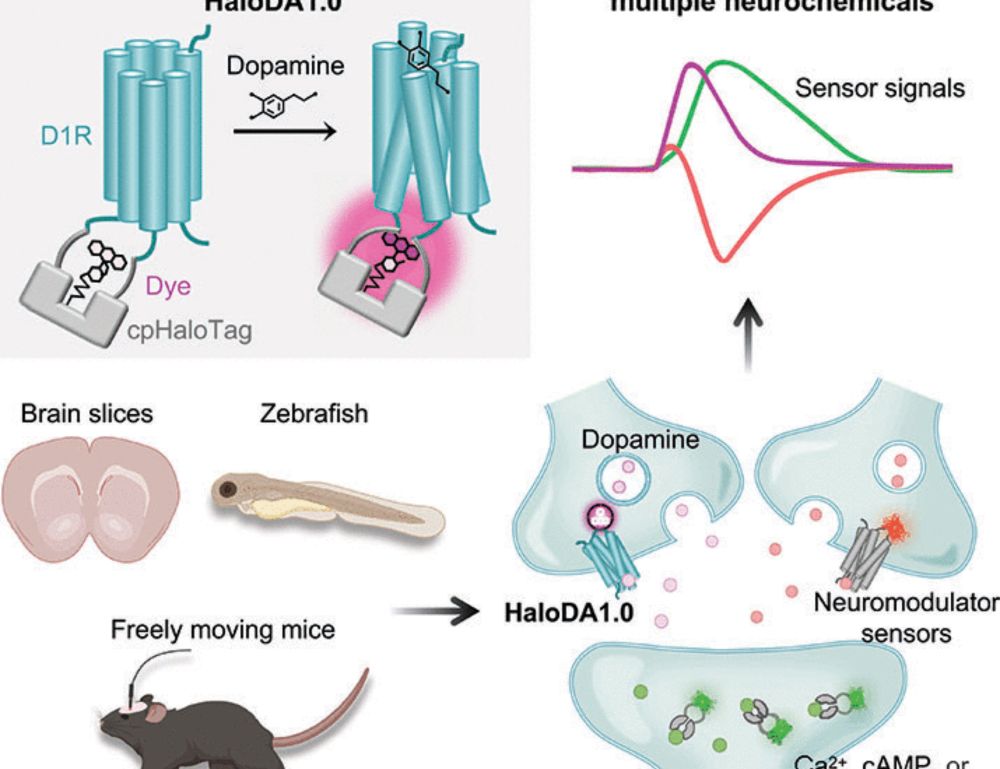
We’re bringing our latest progress in neuromodulator imaging to #SfN2025! Don’t miss Dr. Li’s talk (Nov 19) and our lab’s posters (Nov 16). We look forward to connecting, exchanging ideas, and exploring collaborations. #neuroscience #neuroimaging #biosensors @sfn.org
10.11.2025 15:02 — 👍 11 🔁 2 💬 0 📌 0
Having trouble getting the probes or dyes? Contact us at yulonglilab2018@gmail.com — we will be more than happy to help.
15.09.2025 13:45 — 👍 0 🔁 0 💬 0 📌 0
Glad to see Yu Zheng PhD @zheng-yu.bsky.social highlighting the far-red dopamine sensor for multiplex imaging of in vivo neuromodulation. Happy to share these probes to the community.
15.09.2025 13:44 — 👍 4 🔁 0 💬 1 📌 0

6/ Sustained serotonin release in vCA1 keeps 5-HT2C–expressing pyramidal neuron ensembles, linking temporally separated events. When the gap exceeds the brain’s “safe window”, brief serotonin release fails to drive these ensembles, thus preventing maladaptive learning.
08.08.2025 16:05 — 👍 1 🔁 0 💬 0 📌 0
5/ We mapped molecular specificity in vCA1 using multiplex FISH technique (thanks to Yanyi Huang & Tianyi Chang), and showed that serotonin modulates the associable window via 5-HT2C-expressing pyramidal neurons with CRISPR-Cas9 based gene perturbations.
08.08.2025 16:05 — 👍 2 🔁 0 💬 1 📌 0
4/ Using temporally precise optogenetics, we causally linked DRN→vCA1 serotonergic projections to the regulation of the associable interval in trace fear conditioning.
08.08.2025 16:05 — 👍 0 🔁 0 💬 1 📌 0

3/ We found that serotonin is the key.
In trace fear conditioning, systemic serotonin manipulations bidirectionally shift the associable interval. Using our 5-HT3.0 sensor, we showed real-time, in vivo evidence that serotonin release patterns in vCA1 tightly track this time window.
08.08.2025 16:05 — 👍 1 🔁 0 💬 1 📌 0
2/ The brain needs tight temporal boundaries for associations of cues and threats.
Too narrow → We might miss real threats.
Too wide → We might create false alarms.
The question: What keeps this window just right?
08.08.2025 16:05 — 👍 1 🔁 0 💬 1 📌 0

(3/3) Applying Cort1.0 in vivo: We observed stress-induced 😰CORT elevation in the hypothalamus (e.g., during tail suspension) with Cort1.0 by fiber photometry. Real-time stress hormone readouts, live!
10.07.2025 15:14 — 👍 4 🔁 0 💬 0 📌 0


(2/3) Applying Prog1.0 in vivo: We detected both the maternal behavior-associated🤱 and spontaneous PROG signals ☀️🌙in the hypothalamus with Prog1.0 by fiber photometry.
10.07.2025 15:14 — 👍 3 🔁 0 💬 2 📌 0
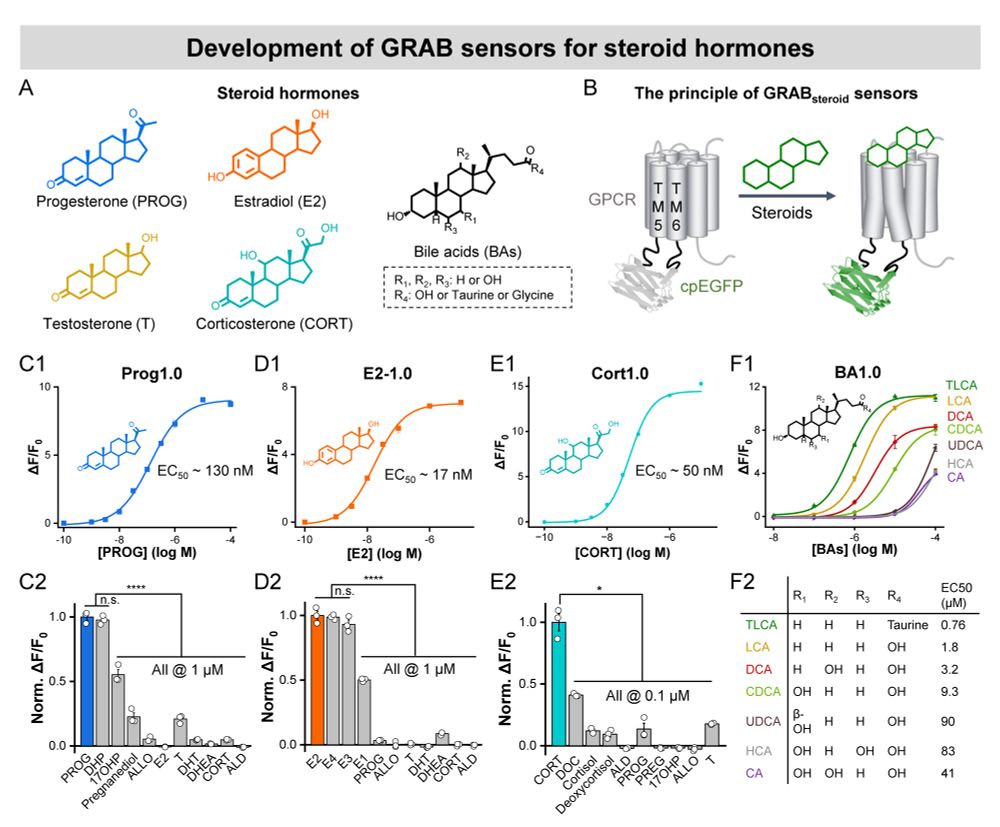
(1/3) Excited to introduce our new GRAB sensors for a series of steroid hormones! These tools enable real-time detection of steroid hormone dynamics in vivo🐭🧠. Happy to share these sensors and welcome any feedback! Please contact yulonglilab2018@gmail.com for information.
10.07.2025 15:14 — 👍 22 🔁 10 💬 1 📌 0
Amazing work by Yu Zheng @zheng-yu.bsky.social, Ruyi Cai @ruyic.bsky.social, and the whole team. Huge thanks to our fantastic collaborators: Yu Mu, Zhixing Chen (@zhixingchen2.bsky.social), Luke Lavis,Eric Schreiter, Kai Johnsson, and Jonathan Grimm.
06.06.2025 05:20 — 👍 1 🔁 0 💬 1 📌 0
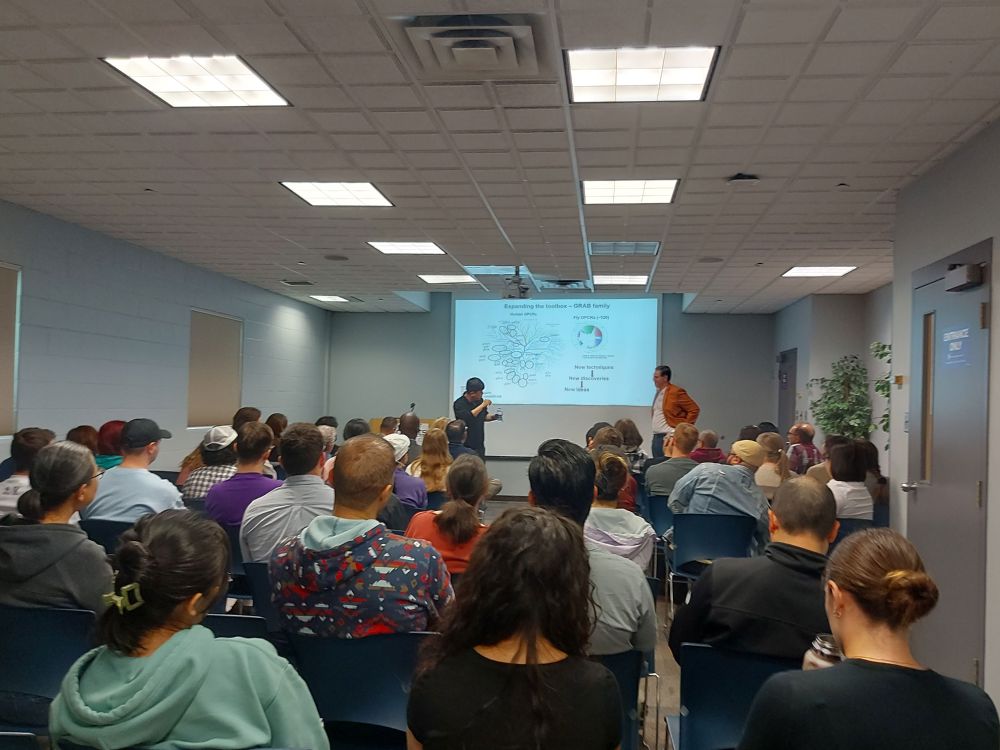
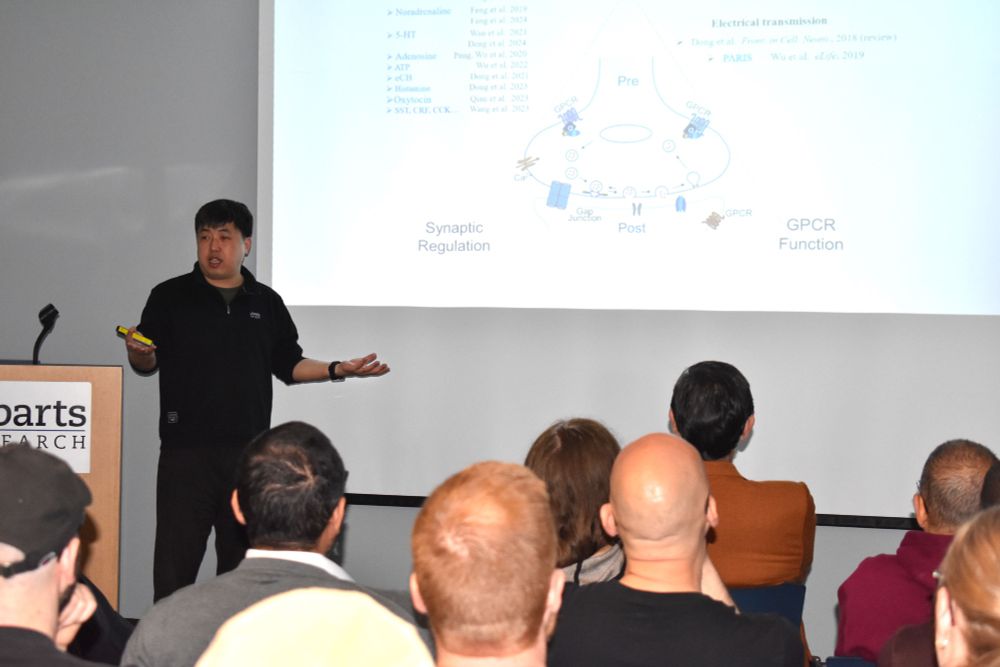
Deepest thanks to @yulonglilab.bsky.social and all those who attended his seminar on GRAB sensors in neuromodulator dynamics hosted by @maximoprado.bsky.social at @westernu.bsky.social.
20.05.2025 19:30 — 👍 7 🔁 4 💬 0 📌 0
Big thanks@westernu.bsky.social @westernubrainscan.bsky.social @tridentpct.bsky.social for inviting! Loved presenting our GRAB sensor work and the great discussions. Hope to visit again!
21.05.2025 01:29 — 👍 8 🔁 3 💬 1 📌 0

Join the "Genetically-Encoded and Chemigenetic Tools for Analysis and Control of Biological Systems" symposium at #ChemPacific2025! Explore cutting-edge tools alongside other world-class science in Hawaii. 🌴🌴
pacifichem.org
18.04.2025 06:48 — 👍 4 🔁 0 💬 0 📌 0
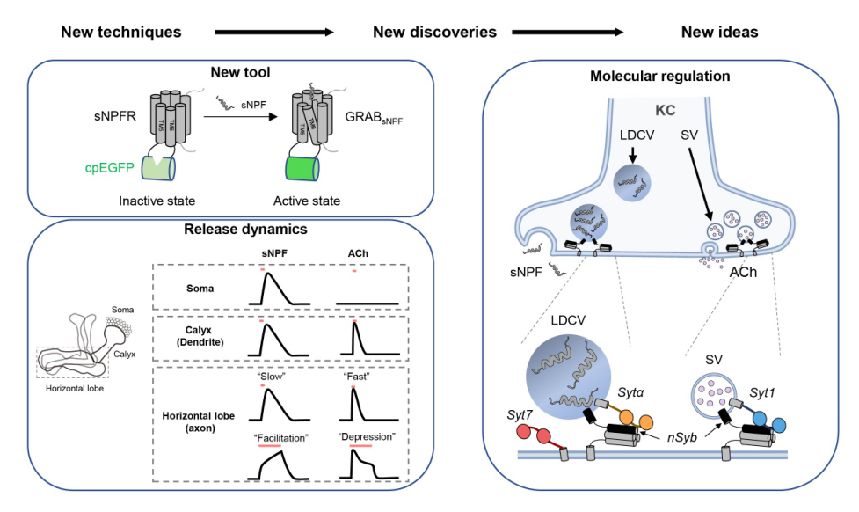
Thrilled to share our latest research published in Nature Communications! Our new GRAB sensor of SNPF promotes discoveries in the dynamics and molecular regulation between neuropeptide and neurotransmitter release in vivo. Check out the full paper here: www.nature.com/articles/s41...
19.01.2025 05:34 — 👍 39 🔁 10 💬 0 📌 0
(6/6) Huge thanks to our team Shu Xie @shuxie.bsky.social , Xiaolei Miao and Guochuan Li, et al, for their excellent work!
28.12.2024 05:49 — 👍 1 🔁 0 💬 0 📌 0
(5/6) The red ACh sensors reliably detect ACh release in various brain regions, including amygdala, hippocampus, and cortex, providing valuable insights regarding the functional role of the cholinergic system.
28.12.2024 05:49 — 👍 1 🔁 0 💬 1 📌 0

(4/6) Through multiplex imaging using 2P microscopy, we've explored the dynamics of ACh and norepinephrine in the visual cortex across various behaviors. rACh1h responds to both water licking and forced running, while NE2m responds only to forced running.
28.12.2024 05:49 — 👍 1 🔁 0 💬 1 📌 0

(3/6) With fiber photometry, we've shown the ability to perform multiplex recordings of ACh and dopamine signals during Pavlovian conditioning tasks, and distinct dynamics between ACh and serotonin during REM sleep.
28.12.2024 05:49 — 👍 1 🔁 0 💬 1 📌 0

(2/6) These sensors are rationally engineered with a chimeric GPCR strategy, providing a superior signal-to-noise ratio compared to existing green ACh sensors.
28.12.2024 05:49 — 👍 1 🔁 0 💬 1 📌 0
(7/7) Great work by Yu Zheng @zheng-yu.bsky.social Ruyi Cai @ruyic.bsky.social , et al, and huge thanks to all of our amazing collaborators including Yu Mu, Zhixing Chen @zhixingchen2.bsky.social , Luke Lavis @rhodamine110.bsky.social , Eric Schreiter, Kai Johnsson , and Jonathan Grimm.
24.12.2024 01:59 — 👍 3 🔁 0 💬 1 📌 0
(6/7) Taken together, HaloDA1.0 provides high versatility for multiplex imaging in cultured neurons, brain slices, and behaving animals, facilitating in-depth studies of dynamic neurochemical networks.
24.12.2024 01:59 — 👍 1 🔁 0 💬 1 📌 0

(5/7) The major breakthrough of this study is the simultaneous multi-color recording of spontaneous and behavior-associated DA, ACh, and cAMP signals in the NAc region in living mice, providing unprecedented insights into complex neurochemical networks.
24.12.2024 01:59 — 👍 3 🔁 0 💬 1 📌 0

(4/7) In zebrafish, we achieved 3-color in vivo imaging by expressing HaloDA1.0 with the red Ca2+ sensor and the green ATP sensor. We observed coordinated activation patterns during electrical shocks and acute seizure attack
24.12.2024 01:59 — 👍 3 🔁 0 💬 1 📌 0

(3/7) In acute brain slices, we achieved simultaneous imaging of three key neuromodulators—DA, ACh, and eCB release—following electrical stimulation and pharmacological interventions
24.12.2024 01:59 — 👍 1 🔁 0 💬 1 📌 0

(2/7) This sensor combines our GPCR activation-based (GRAB) strategy with the cpHaloTag-dye approach, providing high sensitivity and a spectral range from far-red to NIR.
24.12.2024 01:59 — 👍 2 🔁 0 💬 1 📌 0
Nature Reviews Neuroscience features reviews, perspective articles and the latest research news.
https://www.nature.com/nrn/
Group leader at Kavli Institute for Systems Neuroscience. Neuro-photonics and microscopic developer.
Neuroscience Master Student in Geneva University Neurocenter. Foraging in 🐭social decision making.
Past research: emotion, autism mouse model
bordeaux neurocampus • postdoc in the Beyeler lab • anxiety, insula and dopamine
Associate Professor, Department of Translational Neurosciences, The University of Arizona. Neuromodulation; neural circuits of cognition and emotion. Princeton/MIT/Stanford/Cornell/Arizona wardenlab.org
UCSD, HHMI
Neuroscience, protein design, climate change
Job: Neurobiology @ USC
Likes: Bikes, crypto, techno
What’s next?
Identifying the neural basis of innate social behaviors using molecular and genetic tools @Harvard @HHMINEWS
neuroscientist, psychiatrist, writer
optogenetics.org
karldeisseroth.org
https://www.amazon.com/Projections-Story-Emotions-Karl-Deisseroth/dp/1984853694
Prof. of Neuroscience @SinaiBrain · Investigating memory stability & flexibility · Advocate for open science · Mom of two littles · Amateur chef · she/her · denisecailab.com
Neuroscientist. Assistant Professor at Scripps Research.
https://www.ran-lab.org
Dedicated to helping neuroscientists stay current and build connections. Subscribe to receive the latest news and perspectives on neuroscience: www.thetransmitter.org/newsletters/
Neuroscientist. Canadian.
@sfn.org journals JNeurosci and eNeuro serve the field by publishing conceptual advances in neuroscience.
https://www.sfn.org/
The largest nonprofit of scientists & physicians devoted to understanding the brain & nervous system. SfN.org
Account for the American Association for the Advancement of Science, Section L - History & Philosophy of Science:
https://www.aaas.org/sections/history-and-philosophy-science-l
Posts by AAAS-Section L Executive Committee Member @AlisaBokulich.bsky.social
Cutting-edge research, news, commentary, and visuals from the Science family of journals. https://www.science.org








